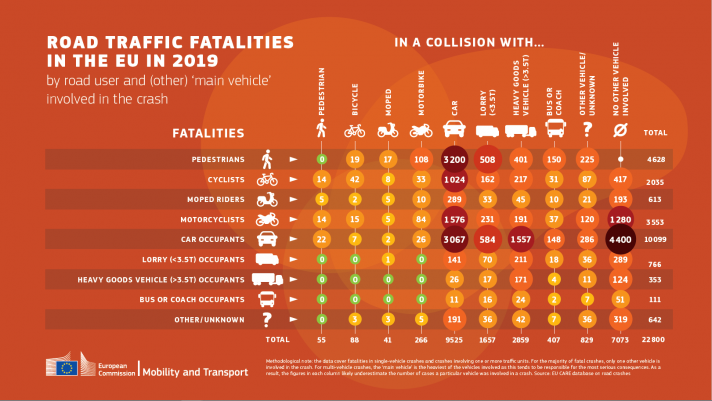
Today the European Commission hosted the annual Excellence in Road Safety Awards, recognising the contributions of the European Road Safety Charter's community of members towards the common goal of improved road safety across Europe. At the same time, the Commission is publishing the final road safety statistics for 2020, ahead of the World Day of Remembrance for Road Traffic Victims this Sunday.
The five winning initiatives are examples of where organisations have delivered specific and measurable road safety actions in their areas of responsibility. The winners in the four categories – associations, enterprises, local/ public authorities and schools/ universities were:
- Fundatia Siguranta Auto Copii (Romania) for its National Children Care Safety Caravan initiative
- Interpolis (the Netherlands) for its hip-hop film and PhoNo app targeting teenagers
- Cork County Council (Ireland) for its Road Safety Virtual Reality Education
- Fundacion Educatrafic (Spain) for its road safety training and education
Nearly 100 initiatives were nominated for the awards. In light of the forthcoming European Year of Youth 2022, it is notable that many of the nominated projects address road safety issues affecting young people. They include a Dutch hit song highlighting the dangers of phone use while cycling; an Irish virtual reality training programme on some of the main road safety distractions; a Romanian initiative to teach young parents how to fit a child car seat correctly; a Spanish awareness-raising campaign to warn young people of the dangers of getting into a car with an intoxicated driver; and a Polish campaign to highlight the importance of safe railway crossing.
More information on the shortlisted projects
Final 2020 statistics on road fatalities
The Commission is today publishing the final figures on road fatalities for 2020, following the publication of the preliminary figures in April 2021. These figures show that an estimated 18 800 people were killed in a road crash last year, an unprecedented annual fall of 17% on 2019. This means almost 4 000 fewer people lost their lives on EU roads in 2020 compared to 2019. However, this was largely due to the effect of the COVID pandemic on mobility, and the drop in fatalities was proportionately less than the sharp falls in traffic levels across the EU.
Preliminary figures for the first six months of 2021 indicate the number of road fatalities increased slightly (2%) compared to the same period in 2020 but was substantially down on the years 2017-2019 (19%).
Also published today is a breakdown of fatalities in the EU by road user and (other) ‘main vehicle’ involved in the crash (2019 data, pending the availability of disaggregated road safety data for 2020). It shows clearly that fatalities overwhelmingly occur in collisions involving cars and trucks, and the need to increase the protection of vulnerable road users (VRU) such as pedestrians and cyclists. EU policies are already evolving in this direction with the new mandatory safety measures introduced by the General Safety Regulation focussed on VRU. Vulnerable users also need to be taken systematically into account by countries when applying the Road Infrastructure Safety Management Directive.

The Commission has also published country reports which provide a detailed statistical analysis of the road safety situation in each country.
Background
The European Road Safety Charter, initiated in 2004 by the European Commission, is the largest civil society platform on road safety. More than 3 000 public and private entities (companies of all types and sizes, automobile clubs, associations, schools, local authorities and others) have committed to the Charter. The Charter invites members to make a commitment, pledging to take a specific measurable action within their area of responsibilities. Since 2006, the yearly Charter Award for excellence in road safety has been presented to organisations that have carried out a particularly interesting and effective road safety initiative.
The European Commission is working to deliver its EU Road Safety Policy Framework 2021-2030 to halve the number of fatalities and serious injuries on European roads by 2030, as a milestone on the way to ‘Vision Zero’ – zero fatalities and serious injuries by 2050.
More Information
Commission’s road safety work and EU road safety statistics and analysis
Road deaths
| Absolute number | Rate per million population | Trend | ||||
| 2020 | 2010 | 2019 | 2020 | 2010/2020 | 2019/2020 | |
| EU-27 | 18 800 | 67 | 51 | 42 | -36% | -17% |
| Belgium | 499 | 78 | 56 | 43 | -41% | -23% |
| Bulgaria | 466 | 105 | 90 | 67 | -40% | -26% |
| Czech Republic | 518 | 77 | 58 | 48 | -35% | -16% |
| Denmark | 163 | 46 | 34 | 28 | -36% | -18% |
| Germany | 2 719 | 45 | 37 | 33 | -25% | -11% |
| Estonia | 60 | 59 | 39 | 45 | -24% | 15% |
| Ireland | 148 | 47 | 29 | 30 | -30% | 6% |
| Greece | 579 | 113 | 64 | 54 | -54% | -16% |
| Spain | 1 370 | 53 | 37 | 29 | -45% | -22% |
| France | 2 538 | 64 | 50 | 39 | -36% | -22% |
| Croatia | 237 | 99 | 73 | 58 | -44% | -20% |
| Italy | 2 395 | 70 | 53 | 40 | -42% | -25% |
| Cyprus | 48 | 73 | 59 | 54 | -20% | -8% |
| Latvia | 139 | 103 | 69 | 73 | -36% | 5% |
| Lithuania | 175 | 95 | 67 | 63 | -41% | -6% |
| Luxembourg | 26 | 64 | 36 | 42 | -19% | 18% |
| Hungary | 460 | 74 | 62 | 47 | -38% | -24% |
| Malta | 11 | 31 | 32 | 21 | -15% | -31% |
| Netherlands | 515 | 32 | 34 | 30 | -4% | -12% |
| Austria | 344 | 66 | 47 | 39 | -38% | -17% |
| Poland | 2 491 | 103 | 77 | 66 | -36% | -14% |
| Portugal | 536 | 89 | 67 | 52 | -46% | -22% |
| Romania | 1 646 | 117 | 96 | 85 | -31% | -12% |
| Slovenia | 80 | 67 | 49 | 38 | -42% | -22% |
| Slovakia | 247 | 69 | 50 | 45 | -33% | -9% |
| Finland | 222 | 51 | 38 | 40 | -18% | 5% |
| Sweden | 204 | 28 | 22 | 20 | -23% | -8% |
| Switzerland | 227 | 42 | 22 | 26 | -31% | 21% |
| Norway | 96 | 43 | 20 | 17 | -54% | -11% |
| Iceland | 8 | 25 | 17 | 22 | 0% | 33% |
| Liechtenstein | 1 | 0 | 0 | 26 | n/a | n/a |
- Source: CARE (Community Road Accident) database. Figures are generally those as reported by police. Population data are from Eurostat. The percentage changes in the table are based on the absolute number of fatalities, not the rate per million inhabitants. Provisional figures EL 2020, IE 2018-2020, FI 2020. In the NL, the number of deaths registered by the police is under-reported and equates to around 85-90% of the total number published nationally (610 in 2020) In PT from 2018 onwards, data includes the NUTS I regions Açores and Madeira although the figure for the trend 2010-2020 excludes these two regions.



